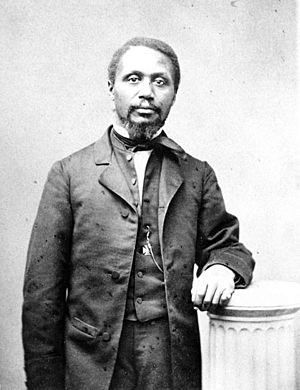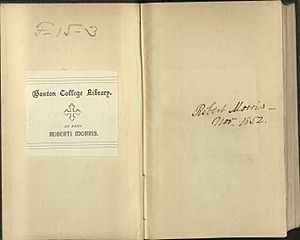Robert Morris (lawyer) facts for kids
Quick facts for kids
Robert Morris
|
|
|---|---|
 |
|
| Born | June 8, 1823 |
| Died | December 12, 1882 (aged 59) |
| Occupation | Lawyer |
| Known for | Abolitionist |
Robert Morris (born June 8, 1823 – died December 12, 1882) was a very important African-American attorney in the United States. He was known as one of the first successful Black lawyers in America. He worked hard to fight for civil rights and end slavery.
Contents
Early Life and Learning
Robert Morris was born in Salem, Massachusetts, on June 8, 1823. When he was 15, he started working for Ellis Gray Loring, a lawyer who was against slavery. Morris helped Loring by copying documents.
Loring was very impressed with how smart Morris was. He decided to teach Morris about law. In 1847, Loring helped Morris become a lawyer in Massachusetts.
Becoming a Lawyer
After becoming a lawyer in 1847, Robert Morris made history. He might have been the first Black male lawyer to file a lawsuit in the U.S. He was also the first Black lawyer to win a lawsuit.
Some people believe Morris and another Black lawyer, Macon Bolling Allen, opened the first Black law office in Boston. However, there is no clear proof that they ever worked together.
Fighting for Freedom
Robert Morris was very active in helping Black people and ending slavery. He took on important cases to fight for equal rights.
Challenging Segregated Schools
Morris was involved in a major case called Roberts v. Boston in 1848. This case was the first time someone legally challenged separate public schools for Black and white children in the U.S.
Morris and Charles Sumner argued that having separate schools was unfair. They said it went against the idea of "separate but equal" treatment. The court in Massachusetts ruled against Morris in 1850. Later, the U.S. Supreme Court used this case to support segregation in 1896. However, the "separate but equal" rule was finally overturned in 1954 by the Brown v. Board of Education case.
Standing Up to the Fugitive Slave Act
The Fugitive Slave Act of 1850 was a law that made it easier to capture and return runaway enslaved people. Robert Morris bravely defended many people under this harsh law.
The Anthony Burns Case
Anthony Burns was an enslaved person who escaped but was captured in Boston. He was put on trial under the Fugitive Slave Law. Robert Morris and Richard Henry Dana Jr. were his lawyers.
Even with their efforts, Burns was ordered to be returned to slavery. This decision caused huge protests in Boston. Federal troops had to be called in to make sure Burns was sent back. Later, people in Boston bought Burns' freedom. He then went to college and became a Baptist preacher in Canada.
The Shadrach Minkins Rescue
Shadrach Minkins was another enslaved person who escaped to Boston in 1850. He was captured under the Fugitive Slave Law. Morris worked with other lawyers to defend Minkins.
Morris, Edward G. Walker, and Lewis Hayden worked together to free Minkins. White and Black members of an anti-slavery group called the Boston Vigilance Committee rescued Minkins from the courthouse. Minkins was hidden and then escaped to Canada. Morris and Lewis Hayden were put on trial for helping Minkins, but they were found not guilty.
The Massasoit Guards
After the Fugitive Slave Law was passed, a man named John P. Coburn started a group of African-American soldiers called the Massasoit Guards. Their job was to protect people in Boston from slave catchers.
Robert Morris asked the Massachusetts government many times to officially recognize and support the Massasoit Guards. However, they never did. This group was an early example of what would become the famous 54th Massachusetts Regiment during the Civil War.
Fighting for School Integration
Robert Morris, along with Thomas Dalton and William Cooper Nell, strongly believed that schools in Boston should be for all races. They argued that it was hard for Black children to feel good about themselves if they were kept separate.
They also pointed out that the schools for Black children were not as good as the schools for white children. Black schools often lacked the same quality of education and resources.
Black communities in Boston had been fighting for equal education since 1787. Early attempts to get access to public schools were denied. Eventually, the city provided some primary schools for Black children, but they were not well-maintained. Black children were also kept out of Boston's high schools. The idea of "separate but equal" schools simply did not work.
Later Career and Legacy
Robert Morris continued his important work. The governor made him a judge in Essex County, Massachusetts, making him the second Black lawyer to hold such a position. He also ran for mayor of Chelsea, Massachusetts in 1866.
Morris loved collecting books. Many of his books are now kept at Boston College, showing his strong connection to learning and knowledge.


